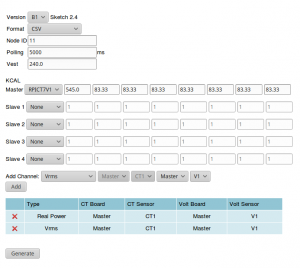RPIZCT4V3T2

Overview
The RPIZCT4V3T2 can be configured to read both single phase and 3 phase systems.
Several temperature sensors can be interfaced. It has support for both DS18B20 temperature sensor and RTD thermocouples.
It is designed to host a user provided Raspberrypi zero.
The main PCB has provision for one extra mezzanine card to extend the number of sensors.
An enclosure solution is proposed using aluminium extruded case.
Specifications
cpu
- Hosts RaspberryPi Zero
- ATmega328 mcu (Arduino UNO)
Sensors
- 4 CT sensors
- 3 AC Voltage
- 1 DS18B20 port (temperature)
- 1 RTD Thermocouple port
Power
- Powered from Raspberrypi (microusb)
Other
- Fits in Aluminium Enclosure from Evatron
- Option to stack mezzanine board for additional sensors.
Recommended sensors
- AC Current sensor:
- SCT-013-000
- SCT-019
- SCT-006
- AC Voltage sensor:
- UK: 77DB-06-09
- EU: 77DE-06-09
- US: 77DA-10-09
- ZMPT101B
- Temperature:
- DS18B20
- Temperature RTD:
- PT100
- PT1000 (modification required)
Temperature Sensor
DS18B20
The temperature port supports mutiple sensor on the same Onewire line.
The sketch is programmed to search for all connected probe at bootup and output all their values when polled.
Multiple probes should connected as shown below.
When a new probe is connected the arduino mcu should be restarted for the new probe to be registered. You can reset the Arduino chip with the command below:
lcl-rpict-config.py -a
RTD Thermocouple
A MAX31865 RTD module is used to interface the RTD sensor with the arduino controller.
There is support for 2 3 and 4 wires thermocouples. Also both PT100 and PT1000 can be used.
Units are sold by default setup for 3 wires PT100 units. Other setup can be configured and require some basic soldering. Full details to configure the MAX31865 module are given by ADafruit webpage here. https://learn.adafruit.com/adafruit-max31865-rtd-pt100-amplifier/rtd-wiring-config
Software Configuration
The documentation for serial configuration can be found on this page.
Over Serial Configuration - Sketch 2.0
The default configuration can be obtained using the command
wget lechacal.com/RPICT/config/B4/rpiz_ct4v3t2.conf
The online configurator can be used with the RPIZ_CT4V3T2. Use a single board of RPICT4V3 when editing the configuration.
Board Reset
The RPIZ_CT4V3T2 has support for software reset. There is no need to physically reset the arduino chip. Reset can be operated from the raspberrypi by using the -a option in the lcl-rpict-config.py.
An example usage will be
lcl-rpict-config.py -a -w myfile.conf
Mezzanine Boards
RPIZ_CT4V3T2 has provision to stack an extra mezzanine board to extend the number of sensors. We currently have 2 type of mezzanine.
Generic Mezzanine
This is a basic board extending all unused I/O pins of the Arduino microcontroller. These are presented as male pin header. Ground and 5V are also available for each pin.
This will only be used if you are planning to write your own firmware.
Each available pins are listed below.
| Atmel Pin | Arduino Analog | Arduino Digital |
|---|---|---|
| PC0 | A0 | D14 |
| PC1 | A1 | D15 |
| PC2 | A2 | D16 |
| PC3 | A3 | D17 |
| PC4 | A4 | D18 |
| PC5 | A5 | D19 |
| ADC6 | A6 | - |
| ADC7 | A7 | - |
| PD2 | - | D2 |
| PD3 | - | D3 |
CT8 Mezzanine
The CT8 mezzanine offers an extra 8 CT connection with a 12 bit ADC. Increasing the total number of CT to 12.
Enclosure
The board has been designed to fit inside an aluminium extruded enclosure. 3D printed end plates are provided. Enclosure kit is available in the shop.
Files
Arduino Sketch
Default RPIZ_CT4V3T2 Sketch V2.1.0.
Programming
The RPIZ_CT4V3T2 can be programmed using the NanoProg.
IMPORTANT. Make sure the Raspberrypi Zero is removed before connecting the NanoProg.
Once the Arduino firmware flashed the default config must be loaded using the lcl-rpict-config.py tool.






